Papers by Sawitri Assanangkornchai
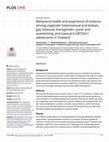
PLOS ONE, Jun 15, 2023
Background Assessment of health disparities between population groups is essential to provide bas... more Background Assessment of health disparities between population groups is essential to provide basic information for resource prioritization in public health. The objective of this study is to assess the extent that behavioral health outcomes and experience of violence varied between cisgender heterosexual adolescents and those who identified as lesbian, gay, bisexual, transgender, queer and questioning, and asexual (LGBTQA+) in the 5th National School Survey on Alcohol Consumption, Substance Use and Other Health-Risk Behaviors. Methods We surveyed secondary school students in years 7, 9 and 11 in 113 schools in Thailand. We used self-administered questionnaires to ask participants about their gender identity and sexual orientation and classified participants as cisgender heterosexual, lesbian, gay, bisexual, transgender, queer and questioning, or asexual, stratified by sex assigned at birth. We also measured depressive symptoms, suicidality, sexual behaviors, alcohol and tobacco use, drug use, and past-year experience of violence. We analyzed the survey data using descriptive statistics with adjustment for sampling weights.
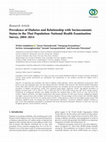
Journal of diabetes research, 2018
Objective. To determine the prevalence and trend of diabetes, related glycemic control, and influ... more Objective. To determine the prevalence and trend of diabetes, related glycemic control, and influential socioeconomic (SES) factors in the Thai population aged ≥20 years during 2004-2014. Methods. Data from the Thai National Health Examination Survey 2004, 2009, and 2014 were used. Age-adjusted prevalence was calculated, and the associations of education levels with prevalence of diabetes and glycemic control were examined using logistic regression. Results. Age-adjusted prevalence of diabetes increased from 7.7% in 2004 to 7.8% in 2009 and 9.9% in 2014 (8.9% among men and 10.8% among women). Proportions of undiagnosed diabetes were slightly decreased but remained high in 2014 (51.2% for men and 41.3% for women). Diabetes prevalence was higher among those with primary education in both sexes; however, undiagnosed diabetes was higher among women with secondary and university educations. The percentages of those treated and controlled slightly improved among men (45.9%) but not among women (36.4%). Unmet glycemic control was also higher among women with secondary education levels and among men with university-level educations. Conclusions. Epidemic diabetes continues to grow in the Thai population, particularly in individuals with lower educational attainment. Measures to detect new cases and strengthen glycemic control should be scaled up.
Springer eBooks, Nov 4, 2020
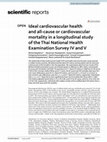
Scientific Reports, Feb 16, 2023
The relationship of ideal cardiovascular health (CVH) and health outcomes has been rarely assesse... more The relationship of ideal cardiovascular health (CVH) and health outcomes has been rarely assessed in middle-income countries. We determined the ideal CVH metrics and association with all-cause and cardiovascular (CVD) mortality in the Thai population. We used baseline data from two rounds of the National Health Examination survey (15,219 participants in 2009 and 14,499 in 2014), and assessed all-cause and CVD deaths until 2020. The prevalence of 5-7 ideal CVH metrics in 2009 was 10.4% versus 9.5% in 2014. During a median follow-up of 7.1 years, the all-cause and CVD mortality rates were 19.4 and 4.6 per 1000 person-years for 0-1 ideal CVH metrics, and 13.0 and 2.1, 9.6 and 1.5, 6.0 and 1.0, and 2.9 and 0.4 per 1000 person-years for 2, 3, 4, and 5-7 ideal CVH metrics, respectively. Participants with 2, 3, 4, or 5-7 ideal metrics had a significantly lower risk of mortality than those with 0-1 ideal CVH metrics (adjusted hazard ratios: 0.75, 0.70, 0.60, and 0.47 for all-cause, and 0.54, 0.52, 0.50, and 0.31 for CVD, respectively). Individuals with a higher number of the modified ideal CVH metrics have a lower risk of all-cause and CVD mortality. Noncommunicable diseases (NCDs) cause 41 million deaths each year worldwide and account for 71% of total deaths. The majority (80%) of this burden occurs in low-and middle-income countries, and cardiovascular disease (CVD) is the leading cause of death 1. The World Health Organization set a global NCD monitoring framework for NCDs in each country with the main target of a 25% reduction in mortality for NCD outcomes in 2030 2. The American Heart Association (AHA)'s Life Simple 7 (LS7) was introduced to assess the extent of ideal cardiovascular health (CVH) at the population level 3. Several studies have shown that the metabolic and behavioral factors in the LS7, which comprises blood pressure, weight (body mass index [BMI]), smoking, diet, physical activity, blood sugar, and the total cholesterol concentration, are associated with all-cause and CVD mortality 4. These metrics have been applied and assessed in the US population, Europe, and some other countries, such as China and Korea, but these countries have different CVH metrics and estimates 5,6. Additionally, these metrics have been rarely assessed in the southeast Asian and low-and middle-income country populations, where the population characteristics and the availability of metrics to be measured might be different. Some metrics were based on local studies with varied strengths of associations. A systematic review reported that the waist-to-height ratio (WHtR) had a better discriminatory power than BMI to predict cardiometabolic health outcome and mortality 7. Studies in the Thai population showed that central obesity, especially the WHtR, was
International Journal of Environmental Research and Public Health, Sep 17, 2022
This article is an open access article distributed under the terms and conditions of the Creative... more This article is an open access article distributed under the terms and conditions of the Creative Commons Attribution (CC BY
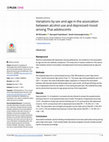
PLOS ONE, Dec 17, 2019
Background Alcohol is associated with depression among adolescents, but variations in the associa... more Background Alcohol is associated with depression among adolescents, but variations in the association by age and sex are relatively unexplored. This study aims to assess variations in the association between alcohol consumption and depressed mood among adolescents by age and sex. Methods We analyzed data from a school-based survey of 38,186 students in junior high school (Year 7 and 9) and senior high school (Year 11). The mean age of the participants was 15.2 (SD = 1.9) years. We used multivariate logistic regression to measure the association between self-reported alcohol drinking (past-year, past-month, and binge-drinking) and history of depressed mood for two weeks or more during the past year. We stratified the analyses by school level (as proxy for age group) and sex of the respondent. Results Approximately 1% of students in surveyed schools refused to answer the questionnaires and fewer than 5% of all questionnaires were invalid. Prevalence of depressed mood was 13.2%. Prevalence of past-year alcohol drinking was 41.0% among those with depressed mood vs. 24.6% among those with no depressed mood (Adj OR = 1.78, 95% CI = 1.60, 1.98). The association was strongest among girls in junior high school (Adj OR = 2.38, 95% CI = 2.03, 2.79) and weakest among boys in senior high school (Adj OR = 1.19, 95% CI = 0.99, 1.42). Conclusion Associations between alcohol drinking and depressed mood were particularly strong among junior high school girls. Youth mental health and alcohol programs should consider prioritizing this subgroup accordingly.
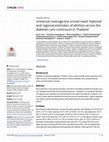
PLOS ONE, Jan 15, 2020
Background Diabetes is a growing challenge in Thailand. Data to assess health system response to ... more Background Diabetes is a growing challenge in Thailand. Data to assess health system response to diabetes is scarce. We assessed what factors influence diabetes care cascade retention, under universal health coverage. Methods We conducted a cross-sectional analysis of the 2014 Thai National Health Examination Survey. Diabetes was defined as fasting plasma glucose �126mg/dL or on treatment. National and regional care cascades were constructed across screening, diagnosis, treatment, and control. Unmet need was defined as the total loss across cascade levels. Logistic regression was used to examine the demographic and healthcare factors associated with cascade attrition. Findings We included 15,663 individuals. Among Thai adults aged 20+ with diabetes, 67.0% (95% CI 60.9% to 73.1%) were screened, 34.0% (95% CI 30.6% to 37.2%) were diagnosed, 33.3% (95% CI 29.9% to 36.7%) were treated, and 26.0% (95% CI 22.9% to 29.1%) were controlled. Total unmet need was 74.0% (95% CI 70.9% to 77.1%), with regional variation ranging from 58.4% (95% CI 45.0% to 71.8%) in South to 78.0% (95% CI 73.0% to 83.0%) in Northeast. Multivariable models indicated older age (OR 1.76), males (OR 0.65), and a higher density of medical staff (OR 2.40) and health centers (OR 1.58) were significantly associated with being diagnosed among people with diabetes. Older age (OR 1.80) and
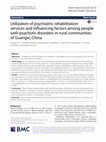
International Journal of Mental Health Systems, Apr 17, 2018
Objectives: To identify the rate and predictors of utilization of rehabilitation services among p... more Objectives: To identify the rate and predictors of utilization of rehabilitation services among people with psychotic disorders in rural communities of Guangxi. Study design: A cross-sectional survey was conducted among individuals with schizophrenia or other psychoses (severe mental disorder, ICD10: F20-F29), aged over 15 years, and their care-givers in Guangxi, China. Trained village doctors located individuals known to them and suspected as having schizophrenia or other psychoses within the target areas and recruited them into the study. Data on demographic characteristics, clinical symptoms and functions, treatment history, and reasons, if any, for non-utilization of mental health service were collected. Logistic regression was used to determine associated factors for utilization of mental health services. Results: A total of 424 individuals experiencing psychosis (mean age 41.4 ± 13.0 years, 60.6% male) and 319 caregivers (mean age 55.3 ± 14.2 years) were interviewed. The median duration of disease was 13.4 years. 83.0% of patients had never used rehabilitation services. Greater use of rehabilitation was associated with having a non-organic disorder (OR = 11.6, 95% CI = 1.6-86.0) and living with a caregivers (OR = 3.2, 95% CI = 1.2-8.3). The top three reasons for not using rehabilitation services were lack of awareness (57.1%), lack of money (14.2%) and lack of belief in the service (12.8%). Conclusions: These findings indicate a high unmet need for psychiatric rehabilitation services among people with psychotic disorders in rural areas of Guangxi. Strategies such as outreach programme and collaborative and partnership network with the local community are needed to encourage people with psychotic disorders in rural communities to increase their utilization of rehabilitation services.
International Journal of Environmental Research and Public Health, Dec 1, 2022
This article is an open access article distributed under the terms and conditions of the Creative... more This article is an open access article distributed under the terms and conditions of the Creative Commons Attribution (CC BY
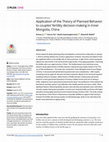
PLOS ONE, Aug 23, 2019
China relaxed its family planning policy and adopted a universal two-child policy on January 1, 2... more China relaxed its family planning policy and adopted a universal two-child policy on January 1, 2016 to actively address the country's aging trend. However, the policy has failed to have any significant effect on the fertility rate of many provinces. In light of the country having the highest sex ratio at birth in the world and the huge burden of the aging population, improving the fertility rate is an urgent priority in China. This facility-based cross-sectional survey aimed to study determinants of fertility decision-making among couples based on the Theory of Planned Behavior. The study was conducted in Inner Mongolia Autonomous Region of China. A structured self-administered questionnaire was completed by 1,399 couples, consisting of wives aged 20-49 years and their husbands. Based on the structural equation modeling method of analysis, determinants of fertility decision-making were perceived behavior control (perceived importance of having a stable income and cost of raising a child), subjective norms (perceived social pressure about "sex preference of the newborn by themselves and their partner") and attitudes (only healthy parents can have a child). Other significant factors influencing fertility decision were ethnicity and education level, with ethnic minority couples having less perception of social norm towards fertility and those with higher education having higher perceived control toward having a (further) child. The study reveals the importance of the China's infrastructure and public facilities to support child-rearing to increase the fertility rate among couples of child-bearing age, which in turn will reduce the burden associated with an aging society.
Scientific Reports, Nov 16, 2021
The original Article has been corrected.
The Lancet Child & Adolescent Health, Jun 1, 2018

Public Health, Dec 1, 2013
Globally, the use of alcohol and illicit substances accounts for 13 disability-adjusted life year... more Globally, the use of alcohol and illicit substances accounts for 13 disability-adjusted life years (DALY’s) lost per 1000 population or 5.4% of the total burden of disease, with 11 due to alcohol and two to illegal substances. In Thailand alcohol, tobacco and illicit substance use ranked first, second and twelfth among the top risk factors for DALY’s lost in both sexes in 2009. Several attempts have been made to combat this escalating problem in Thailand, including the development of prevention and treatment packages and employment and training of healthcare workers to encourage early intervention and engagement in treatment. The implementation of the World Health Organisation recommended Alcohol, Smoking and Substance Involvement Screening Test (ASSIST) and its linked brief intervention (ASSIST-BI) in primary care settings is one such effort. The aim of this paper is to report the results of our work on a model for developing and implementing an ASSIST-BI service in primary care units of four districts in the north-eastern
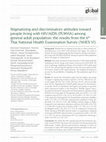
Journal of Global Health
Background Thailand has an ongoing action plan to reduce human immunodeficiency virus (HIV) discr... more Background Thailand has an ongoing action plan to reduce human immunodeficiency virus (HIV) discrimination and stigma. We aimed to monitor the level of stigmatizing and discriminatory attitudes toward people living with HIV/AIDS (PLWHA) among the general adult population and to investigate its related factors. Methods This study was based on data from the 6 th Thai National Health Examination Survey, a large-scale country-wide survey in 2019-2020. We used a multistage sampling technique and included 11 843 adults aged 20 to 59. We collected data through face-to-face interviews which included six items related to HIV stigma domains. We weighted all analyses to account for the probability of sampling the Thai population aged 20 to 59 years. Results We found that anticipated stigma had the highest percentage of negative stigmatizing attitude responses (78.5%), followed by perceived stigma (66.6%), fear of HIV infection (54.4%), and social judgment (28.2%). Regarding the UNAIDS global indicator for discriminatory attitude, 48.6% of respondents had negative perceptions to questions about experienced stigma or discrimination. Multiple logistic regression showed that factors associated with discriminatory attitudes toward PLWHA were being aged 20-39 (adjusted odds ratio (aOR) = 1.32, 95% confidence interval (CI) = 1.18-1.47) or 50-59 (aOR = 1.23, 95% CI = 1.09-1.40) compared to being aged 40-49, being Muslim compared to Buddhist (aOR = 1.73, 95% CI = 1.46-2.06), being married compared to being single (aOR = 1.15, 95% CI = 1.04-1.28), holding certificate degree or higher compared to not studying or studying at a primary level (aOR = 0.81, 95% CI = 0.68-0.97), living in the Northeast (aOR = 1.27, 95% CI = 1.12-1.45) and Bangkok (aOR = 1.30, 95% CI = 1.12-1.51) compared to living in the North, having no HIV/AIDS infected relative or acquaintance compared to having an HIV/AIDS infected relative or acquaintance (aOR = 1.56, 95% CI = 1.41-1.73), and not obtaining an HIV test compared to obtaining it (aOR = 1.10, 95% CI = 1.02-1.19). Conclusions We found that HIV stigmatizing and discriminatory attitudes toward PLWHA decreased, but remained concerning among Thai adult people. A public education and awareness campaign, as well as an intervention to reduce HIV-related stigma and discrimination in the country's health care facilities, must still be maintained.

International Journal of Alcohol and Drug Research
From comparisons of World Health Organization statistics, it is clear that people in lower-income... more From comparisons of World Health Organization statistics, it is clear that people in lower-income countries experience more harms per litre of alcohol and different types of harms compared to those from higher-income countries. Yet studies in higher-income countries dominate research on policies to prevent alcohol problems. The paper reports on results of collaborative work to map priority areas for research relevant to low- and middle-income countries. Research focus areas were identified and discussed among potential coauthors from diverse fields with relevant knowledge, with agreement reached on an initial list of seven research priority areas. Areas identified include: (1) the effects of choices (e.g., national vs. local, monopoly vs. licensing system) in organising the alcohol market; (2) involvement/separation of alcohol industry interests in decisions on public health regulation; (3) options and effectiveness of global agreements on alcohol governance; (4) choices and exper...

Journal of Education and Health Promotion, 2022
BACKGROUND: Self-care activities are associated with prognosis of type-II diabetes mellitus patie... more BACKGROUND: Self-care activities are associated with prognosis of type-II diabetes mellitus patients and include medication adherence, dietary adherence, physical activity, self-monitoring of blood glucose (SMBG), and appropriate foot care. The behaviors of a patient's family members can influence the patient's self-care activities, but little data exist on this association. The objective of this study was to assess the extent of the association between behaviors of family members of Type-II diabetes patients and the patients' self-care activities. MATERIALS AND METHODS: We conducted a cross-sectional study at a teaching hospital in Kathmandu, Nepal, and interviewed 411 outpatients with Type-2 diabetes mellitus. We used exploratory factor analysis to group family members' behaviors into 3 domains (”authoritarian,” “supportive,” and “planning” behaviors) and graded the level of the behavior into 3 categories (”high” vs. “medium” vs. “low”) according to its ranking dis...

Drug and Alcohol Dependence, 2021
BACKGROUND In Thailand, alcohol is consumed in social setting. The Thai government introduced a b... more BACKGROUND In Thailand, alcohol is consumed in social setting. The Thai government introduced a ban on alcohol sales and other measures at the beginning of COVID-19 lockdown with gradual lifts. However, drinking behaviors, behaviors of community members, and alcohol marketing activities during the ban and lifts have not been described. METHODS We contracted a survey research firm to conduct four phone-based cross-sectional surveys between April and July 2020 (n = 6239 participants in total). Participants were recruited from all regions and Bangkok. We also summarized alcohol control measures as reported by multiple sources. We analyzed data from Waves 1 thru 4 using descriptive statistics with adjustment for sampling weight. RESULTS A total of 6239 persons participated in the 4 waves of surveys. Among survey respondents who were drinkers, half did not drink alcohol during the alcohol sale ban while one-third reported drinking less than usual in the past 30 days. Almost no participant reported drinking more than usual. During the ban (Wave 1), one-sixth of respondents noticed social drinking in their areas while less than 6 percent reported witnessing alcohol sale. Online parties were the predominant alcohol marketing activity, but became less common during Wave 3 compared to Wave 2. DISCUSSION AND CONCLUSIONS Ever drinkers either abstained from alcohol or drank less than usual during the ban on alcohol sale. However, social drinking and alcohol sale persisted despite the ban.
Textbook of Addiction Treatment: International Perspectives, 2014
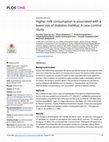
PLOS ONE
Background & aims Studies have determined that people with genetically defined lactase non-persis... more Background & aims Studies have determined that people with genetically defined lactase non-persistence have lower dairy intake that may lead to an increase risk of various non-communicable diseases. Furthermore, lactase non-persistence itself has been associated with insulin resistance. However, data on lactase non-persistence status and dairy intake in developing countries are sparse. We therefore aimed to define 1) the prevalence of lactase non-persistence among individuals with diabetes and non-diabetes in Thai population and 2) the links between lactase non-persistence, milk consumption, and risk of diabetes mellitus. Methods We conducted a case-control study from participants of the National Health Examination Survey. DNA was isolated from the blood for LCT −13910C>T (rs4988235) polymorphism and processed using the Bio-rad c1000 touch thermal cycler and MALDI-TOF Mass Spectrometry MassARRAY Typer v4.0 (Agena Bioscience, San Diego, CA, USA) at the Center for Medical Genomics,...
International Gambling Studies

Uploads
Papers by Sawitri Assanangkornchai